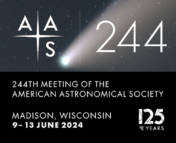
Welcome to the summer American Astronomical Society (AAS) meeting in Madison, WI! Astrobites is attending the conference as usual, and we will report highlights from each day here. You can also follow us on Bluesky at astrobites.bsky.social for more meeting content. We’ll be posting once a day during the meeting, so be sure to visit the site often to catch all the news!
Table of Contents:
- Plenary Lecture: Dark and Quiet Skies for the Future of Astronomy and of the Space Environment (Aparna Venkatesan & Teznie Pugh; University of San Francisco and McDonald Observatory, UT Austin)
- Press Conference: From the Galactic Center to the Galactic Disk
- Unlocking the Mysteries of Exoplanets: The Crucial Role of Laboratory Research (Erika Kohler, NASA Goddard Space Flight Center)
- Press Conference: Massive Black Holes and Surprising Spirals
- Plenary Lecture: Leveraging AI to Transform the Astronomy Data Revolution into a Discovery Revolution (Cecilia Garraffo, Center for Astrophysics | Harvard & Smithsonian)
- Plenary Lecture: With a Wild Surmise: A New Era of Exoplanet Exploration (Tom Beatty, University of Wisconsin at Madison)
Plenary Lecture: Dark and Quiet Skies for the Future of Astronomy and of the Space Environment, Aparna Venkatesan & Teznie Pugh (University of San Francisco and McDonald Observatory, UT Austin) (by Will Golay)
Aparna Venkatesan (University of San Francisco) and Teznie Pugh (McDonald Observatory, UT Austin) started the second day of the AAS by discussing the exponentially growing challenges of protecting dark and quiet skies. Venkatesan and Pugh are co-chairs of COMPASSE (Committee for the Protection of Astronomy and the Space Environment), an AAS committee dedicated to preserving the viability of ground-based, orbital, and lunar astronomy.
There are growing threats to astronomy across the electromagnetic spectrum, the most well known being light pollution. A recent paper used citizen science reports of star visibility and found that the reduced number of visible stars can be explained by the sky brightness increasing between 7% and 10% every year for the last 11 years. If this trend continues, the number of visible stars in the night sky will halve every 10 years, an existential threat to ground-based optical astronomy. The impact on major astronomical observatories is also profound. Another recent result showed that about two-thirds of major astronomical observatories have sky brightnesses exceeding the International Astronomical Union’s recommended 10% above natural levels.
However, the threat does not end in the optical or on the ground. Radio-frequency interference (RFI) is another rapidly growing problem that could wipe out ground-based radio observatories. At the other end of the spectrum, space-based nuclear power could threaten space-based high-energy observatories like Chandra (#SaveChandra). Also in space, the growing number of satellites has posed a major problem for ground-based observation. Eighty percent of all active satellites have been launched in the last four years, and 60% of active satellites are part of the Starlink constellation. As of May 29, 2024, there are 547,267 combined International Telecommunications Union (ITU) & Federal Communications Commission (FCC) applications for new frequency allocations for space-based satellites. The impact of these satellites is manyfold: from increasing the sky brightness, streaking in images, and the impact of launches (which are not yet well known), 500,000 satellites would make ground-based astronomy almost impossible. Given current predictions on satellite launchers, the Vera Rubin Observatory anticipates streaking in 30% of images during twilight hours.

The impact of brighter skies extends far beyond professional astronomers. Amateur astronomers will also suffer the same effects, and the implications on animal and bird migration patterns are just starting to be understood. Some Indigenous populations, which have already disproportionately been impacted and repeatedly displaced, rely on wayfinding with constellations and asterisms. The rising sky brightness already has measurable impacts on this navigation method by reducing the number of visible stars.
However, all is not lost! COMPASSE is taking many steps to combat these challenges. COMPASSE provides templates for local ordinances and advocates for dark skies, education, and outreach in local communities. The committee also works with government organizations like the FCC, the Federal Aviation Administration, the US State Department, etc., to provide comments on the impact of new policies on dark and quiet skies. They are increasing awareness by publishing in scientific journals and popular media outlets, and they’ve taken many more steps to begin combating this issue. Venkatesan and Pugh highlighted that the story is not complete yet, and that it is our story to write by getting involved in advocacy for dark and quiet skies.
Press Conference: From the Galactic Center to the Galactic Disk (by Nathalie Korhonen Cuestas)
The first press conference of the day included five different speakers who described their work on Sagittarius A* (Sgr A*) – the supermassive black hole (SMBH) at the center of our galaxy – and its surroundings. Sgr A* gives us a rare chance to study inactive black holes, which are otherwise too faint to observe with much detail.
The first speaker, Grace Sanger-Johnson (Michigan State University), presented X-ray observations of Sgr A*, which were taken over a period of eight years by the NuSTAR telescope. A puzzling characteristic of Sgr A* is that it flares in X-ray wavelengths. Over a period of a couple hours, Sgr A* can become up to 600 times brighter than it normally appears. The origin of these cosmic fireworks is currently unknown, but there are two main hypotheses: the flares could originate from the magnetic fields in plasma very close to the black hole, or they could be the result of a star coming too close to the black hole and losing some of its mass. Sanger-Johnson’s observations show that there is a correlation between the brightness of a flare and the hardness of a flare. Here, “hardness” refers to how much of the light emitted is at shorter, more energetic wavelengths. A harder flare has more energy at shorter wavelengths, and Sanger-Johnson found that harder flares were generally brighter. This correlation could point to two different origins for these X-ray flares: one which produces dimmer, softer flares, and another that produces brighter, harder flares. Further observations of Sgr A*’s flares will help astronomers determine if this is indeed the case.
Next up was Jack Uteg, a rising sophomore at Michigan State University. His talk shifted focus from Sgr A* to the ring of molecular gas that resides around 100 parsecs from the galactic center. This gas, known as the central molecular region (CMZ), can be observed in X-ray, but we know that molecular gas cannot emit at this wavelength by itself. Therefore, these X-rays may have originated from Sgr A*, and are now being reflected by the CMZ. Uteg specifically studies the emission from a region known as the Bridge Cloud. The distance between Sgr A* and the Bridge Cloud means that light takes about 200 years to travel from Sgr A* to the Bridge Cloud, where it can be reflected. This means that any observations of the Bridge Cloud tell us what Sgr A* was up to 200 years ago. Using X-ray observations taken over 24 years, Uteg reconstructed the X-ray emitting history of Sgr A* and found that around 200 years ago, Sgr A* underwent an outburst that made it 100,000 times brighter than it normally is!
Continuing with the theme of the CMZ, Dylan Paré (Villanova University) discussed his observations of the magnetic fields in the CMZ. The FIREPLACE (Far-Infrared Polarimetric Large-Area CMZ Exploration) survey used the polarization of light from the CMZ to map the magnetic fields that thread the clouds. Paré found that the magnetic field was preferentially oriented in two directions, and that higher density regions such as The Brick (see the first inset panel in the image below) have more well-aligned magnetic fields. In the galactic disc, the opposite is observed to be true – denser clouds are less likely to have well-aligned magnetic fields. While further analysis of the different regions of the CMZ is needed, it’s possible that the observed magnetic fields are the result of a large-scale magnetic field, running perpendicular to the galactic plane, being sheared by the molecular clouds.

Another region observed by the FIREPLACE survey is Sagittarius C (Sgr C), an intriguing region with unusually high star formation. Jianhan (Roy) Zhao (UCLA) described the various components of Sgr C and how we can use them to learn more about the mechanisms at play in the CMZ. In the image you can see bright yellow streaks, which are radio filaments. One of these filaments originates in Sgr C, appearing to emanate from a shell of ionized gas that surrounds a molecular, star-forming cloud. One possible source of radio filaments is magnetic reconnection, a high-energy phenomenon which can accelerate electrons and cause them to emit in the radio wavelengths. In Sgr C, Zhao found that the magnetic field lines are converging towards the radio filament, supporting the idea that magnetic reconnection is powering the radio emission. The fact that the radio filament is seen to originate in an ionized region further supports this idea, since in order for electrons to be accelerated, they have to be free.
Last but not least was Dr. Anthony Minter (Green Bank Observatory), who discussed his search for dust and molecules in Smith’s High Velocity Cloud (HVC). HVCs are clouds that are flying towards the Milky Way, potentially providing the fuel needed to sustain star formation. Clouds in the Milky Way contain different molecules and dust grains, but Smith’s HVC was observed to contain no dust or molecules. It could be that the cloud originally did contain dust and molecules, but over time, they became dissociated, or, it could be that the cloud was formed from a pristine environment. In the galactic disc, we know that clouds further from the galactic plane have less dust and molecules. Minter found that clouds near the galactic center have a similar, but steeper gradient. This means that a cloud at the galactic center will have fewer molecules and dust grains than a cloud at a similar height from the galactic plane, but over the galactic disc. These kinds of abundance patterns help us to understand the structure of the Milky Way and potentially help reconstruct the events that determined the evolution of our galaxy.
Unlocking the Mysteries of Exoplanets: The Crucial Role of Laboratory Research, Erika Kohler (NASA Goddard Space Flight Center) (by Catherine Slaughter)
This summer’s AAS meeting is a joint session with the Laboratory Astrophysics Division (LAD). As part of this, Dr. Erika Kohler (NASA GSFC) gave Tuesday’s midday plenary lecture, promoting the use of lab-based experiments in astrophysical research, as well as highlighting a number of her group’s projects, including the prep work for the forthcoming Deep Atmosphere Venus Investigation of Noble gases, Chemistry, and Imaging (DAVINCI) mission.
The talk started out posing a question which motivates much of the work we do as scientists: “We found it, why not study it?” Kohler goes on to describe how recent technological innovation has allowed us to develop advanced spacefaring probes and respond to this question using in situ measurements of solar system planets. The catch, she notes, is that even the most advanced tech could not make in situ measurements of exoplanets. From this, Kohler outlines her talk’s key takeaways: that lab research is fundamental and complements all other astrophysics work, and that (given the cross-disciplinary nature of exoplanet research) communication pathways and user engagement propel us forward. To underscore these ideas she gives two examples from her own research.
The first comes from a study of cloud formation in exoplanet atmospheres. Solar system planets, Kohler explains, represent a very limited region of possible exoplanet parameters, especially in terms of atmospheric pressure and temperature. “If you’re only designing experiments to describe [the solar system planets],” she says, “you’re missing a whole Universe out there.” In the project, Kohler and her team used lab-based experiments to recreate the very extreme atmospheric environments found on distant exoplanets. Their goal was to experimentally determine saturation vapor pressure curves – mathematical descriptions of the pressures and temperatures at which a given material will form clouds – for a number of known and expected molecules in exoplanet atmospheres. The preexisting curves were created using calculations based on Earth-like conditions. They found that the heights at which clouds form in a given atmosphere are different in extreme environments; a result which changes our interpretation of possible exoplanet atmosphere observations. This is a result that could only be reasonably obtained in a lab setting.
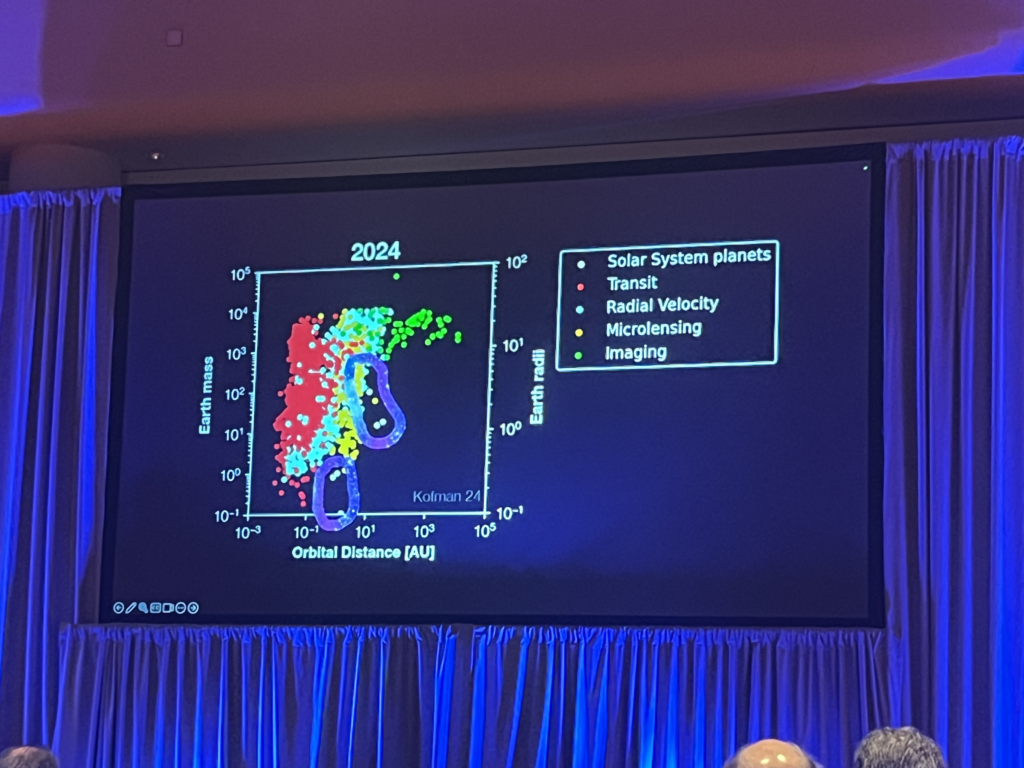
The second example is a study conducted in preparation for the launch of DAVINCI. The mission will include a probe which descends down to the surface of Venus, taking images of the surface in near-IR and making atmospheric measurements along the way. In order to obtain usable images, however, it is important to ensure that the atmosphere of Venus is reasonably transparent to infrared light. Kohler’s group began by studying the changing opacity of CO2 in the varying temperatures and pressures of Venus’ atmosphere. They conducted a simulated descent, taking observations of IR transmission through CO2 at conditions mimicking the atmosphere from 55 to 7 km above the surface. In doing so, they are able to identify the wavelengths at which the atmosphere can be expected to become opaque at some point in the probe’s journey. Along with being foundational work for the future DAVINCI mission, these experimental results have huge implications for JWST, which observes in the mid-IR, highlighting the necessity of lab work as a supplement to distant observation.

Kohler finishes the talk encouraging the crowd to pursue three actionable challenges: 1. Talk to people in other subfields. 2. Look at the assumptions in our own research, and see if they’ve ever been verified in the lab. 3. Take a multi-method approach to research, combining lab-based, modeling, and observational techniques. She leaves us with a reminder that lab-based research allows us to both describe and predict astrophysical observations, and that we want to be prepared before first light.
Press Conference: Massive Black Holes and Surprising Spirals (by Kerry Hensley)
Fan Zou (Penn State University) opened the afternoon press conference with a discussion of supermassive black hole growth. Despite nearly all massive galaxies having supermassive black holes, it’s still not known exactly how these objects get so massive. Accretion and mergers are the two possible growth mechanisms, and researchers need to understand both processes to reconstruct the growth history of black holes. Zou explained that astronomers study black hole accretion through X-ray observations, and they study mergers through supercomputer simulations. Combining results from Chandra X-ray Observatory, eROSITA, and XMM-Newton — three premier X-ray observatories — with output from the IllustrisTNG simulations, Zou’s team found that accretion played a larger role in black hole growth than mergers did under most circumstances. The growth rate due to both mechanisms was higher in the early universe, although the two mechanisms have declined at different speeds. Today, mergers play a larger role relative to accretion than in the early universe.
Robert Wheatley and Catherine Grier (University of Wisconsin-Madison) reported on their study of a quasar: a supermassive black hole with a hot, luminous accretion disk that emits radiation across most of the electromagnetic spectrum. Quasars often have powerful winds or outflows that travel at millions of miles per hour out from the accretion disk. Because these winds can block the light from the hot accretion disk, they are visible in quasar spectra as absorption lines. Using observations from the Sloan Digital Sky Survey Black Hole Mapper Reverberation Mapping Project, Wheatley, Grier, and collaborators demonstrated that the outflows from the quasar SBS 1408+544 (also called SDSS-RM 613) have been accelerating over the past eight years because of radiation pressure from the luminous accretion disk. This acceleration was evident from the blueward shift of an absorption line of carbon. While previous observations have hinted at accelerating quasar outflows in a handful of spectra, this new work uses 130 spectra, providing an unprecedented new look at this phenomenon.
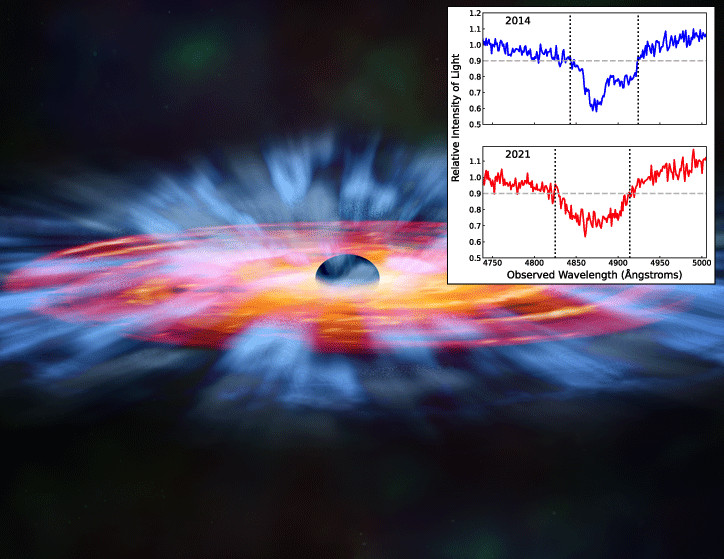
Next, Riccardo Arcodia (MIT) presented a study on massive — not supermassive! — black holes in low-mass galaxies. Studying these somewhat-less-than-supermassive black holes in the nearby universe can help researchers understand how supermassive black holes grew from lower-mass seeds in the early universe. Accreting black holes emit light across the electromagnetic spectrum and can be highly variable, so Arcodia’s team searched for low-mass galaxies that are variable in the optical and infrared to identify candidate massive black holes. Of the 200 candidate massive black holes, only 17 emitted X-rays. This result is unexpected because accreting supermassive black holes are extremely luminous in X-rays, and the team estimated that X-rays from the black holes in their sample should have been detectable. This might mean that lower-mass black holes have a different accretion mode compared to supermassive black holes, possibly because of the lower gravity, clumpier interstellar medium, or other factors.
Lastly, Vicki Kuhn (University of Missouri Columbia) presented some new results from JWST on spiral galaxies. Previous studies using the Hubble Space Telescope have found that there are very few spiral galaxies earlier than a redshift of z = 2, which corresponds to when the universe was just a few billion years old. Kuhn’s team identified 873 galaxies with high stellar mass and redshifts between 0.5 and 4 in observations from JWST, which can look farther back in time than Hubble can. A team of six researchers visually classified each galaxy in the sample as spiral or not, and they found that JWST sees more spirals than Hubble did, especially at low redshift. To account for the fact that spiral structure is harder to discern at high redshift, Kuhn’s team created a sample of mock high-redshift galaxies. After determining how redshift affects the fraction of galaxies in which spiral structure is visible, the team found that about 30% of galaxies are spirals out to a redshift of z = 3. This is far more spirals than found in previous studies, suggesting a need to recalibrate our expectations for when and how spiral structure formed in early galaxies.
Plenary Lecture: Leveraging AI to Transform the Astronomy Data Revolution into a Discovery Revolution, Cecilia Garraffo (Center for Astrophysics | Harvard & Smithsonian) (by Will Golay)
Cecilia Garraffo is a researcher at the Center for Astrophysics | Harvard & Smithsonian and the director of AstroAI. She is an expert in machine learning (ML) and artificial intelligence (AI) data analysis methods. She has developed novel techniques for using machine learning to uncover unique and exciting results from large astrophysical datasets. In her talk, she aimed to highlight what AI can contribute to research in astrophysics.
Garraffo motivated the need for AI methods by reminding us of an important point: although we are building massive observatories that will be coming online in the next five to ten years, are we, as a community, prepared for the immense data influx that will ensue? Once observatories like the Vera Rubin Observatory and the Square Kilometre Array begin observing, we will generate more data in one year than all currently existing astrophysical data. We are entering the era of petabyte astrophysics, an era we are not yet prepared to begin. The data volumes are not the only consideration: as astrophysics research becomes increasingly multi-wavelength and multi-messenger, causing datasets to become heterogeneous, it is even more critical that we have methods that can unify the picture and maximize the scientific value of such unique datasets.
AI is one tool we can apply to begin preparing for the upcoming massive influx of data. Garraffo argues that AI has the unique ability to search for patterns and classes intentionally (even if we don’t know what those patterns are a priori), enabling a chance for discovery spaces that would otherwise be inaccessible in smaller datasets. Even the most basic dimensionality reduction and clustering methods have successfully identified new anomalies in large datasets that we can later follow up on.
How exactly do we execute such a search using ML methods? The astronomy community needs experts in AI to help develop strategies specific to our kind of data. Astronomical data often differs from the data used to train large language models (LLMs) in several ways. Our data are biased and complex, could be multimodal, almost always incomplete, and undoubtedly sparse. To address these issues, we need to take specific steps to prepare our data and our ML models, which require user expertise in identifying methods and successfully applying them in the context of astrophysical research.
Garraffo then shared several examples of how AI has been used in various research contexts inside the AstroAI collaboration. One particularly striking example she shared was using ML methods to generate new “realistic” images of a black hole accreting material for comparison with images from the Event Horizon Telescope (EHT). Since general relativistic magnetohydrodynamic simulations are costly to run, we can use ML methods to interpolate between the model’s parameters. In the case of EHT, they are interested in using these methods to generate images of a black hole with differing spins, significantly affecting how the accretion will appear in EHT images.
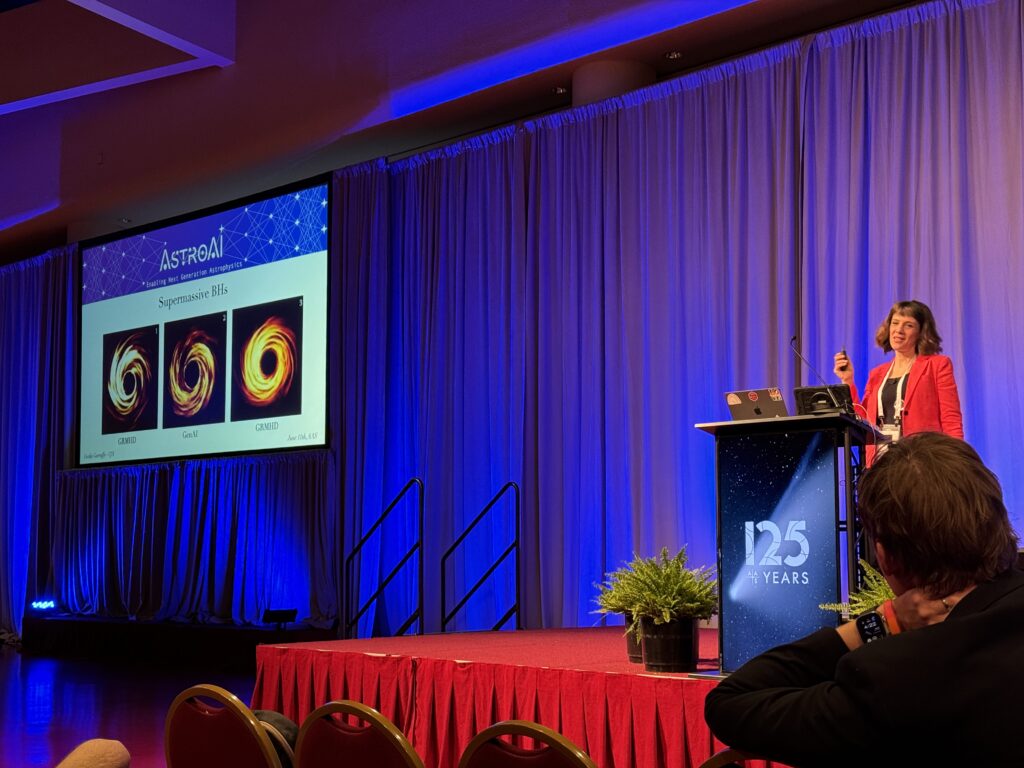
Although ML astrophysics methods are just starting, Garraffo is excited to continue sharing them and educating the community via the AstroAI collaboration. The collaboration aims to educate students about how AI methods can be used in astrophysics research and begin developing a new era in which these methods are common throughout a wide variety of subfields. Stay tuned for more updates about the AstroAI collaboration at the Center for Astrophysics on their website!
Plenary Lecture: With a Wild Surmise: A New Era of Exoplanet Exploration, Tom Beatty (University of Wisconsin at Madison) (by Jessie Thwaites)
Wrapping up today’s talks was Dr. Tom Beatty, whose plenary lecture explored exoplanets, specifically how we can classify them. We already know of more than 5,600 exoplanets, and that number just keeps growing! He discussed how we can measure a planet’s atmosphere to learn how exoplanets form, explore what makes a planet habitable, and search for signatures of water and oxygen that would be necessary to support life.
The attempt to classify exoplanets is multifaceted, he says, including searching for trends in their mass, gravity, age, metallicity, clouds, specific elemental abundances, and more. But these quantities have complicated relationships; for example, he discusses how ambiguity in cloud models on the planet’s surface can change the abundance measurement we get. These measurements of the spectra of these planets are made via transmission (seeing the spectral lines that appear when the planet passes in front of its star) and emission (seeing the spectral lines than disappear when the planet passes behind its star).
Central to the themes of his talk were how improvements in technology have made these detailed and accurate measurements possible. Initially, these measurements were done with the Spitzer Space Telescope, and massively improved upon with the Wide Field Camera 3 instrument on the Hubble Space Telescope, which allowed for more precise and spectroscopic measurements. And now, with JWST’s improved sensitivity, we can measure carbon and oxygen molecules in exoplanet atmospheres for the first time, get spectroscopic measurements of clouds, and even search for signatures of life on exoplanets!
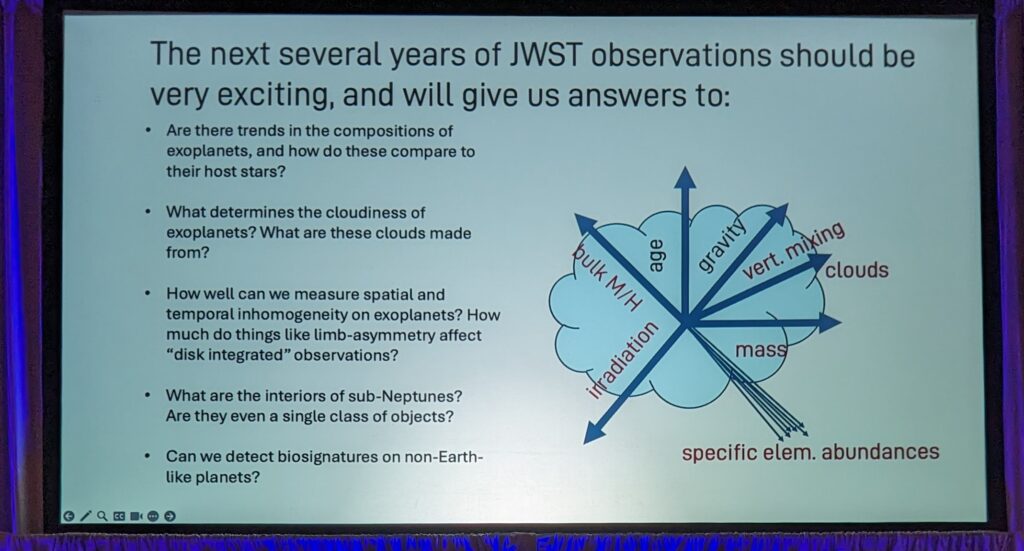
But searching for biosignatures requires more than just understanding the atmosphere on these planets, he says, so researchers have formed the Wisconsin Center for Origins Research (WiCOR) to bring together astronomy, chemistry, integrative biology, geoscience, bacteriology, botany, and atmospheric and oceanic studies to search for life on exoplanets in a multidisciplinary way.

